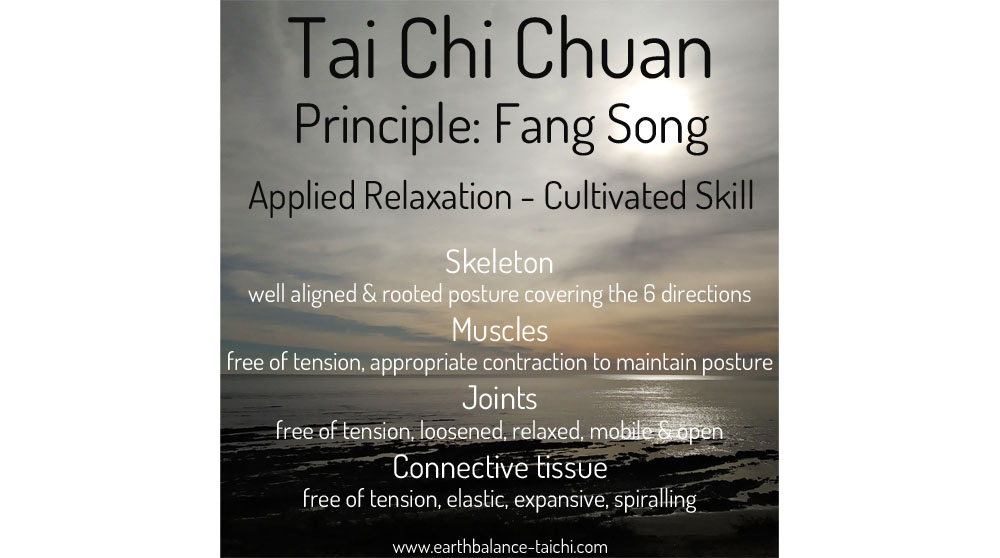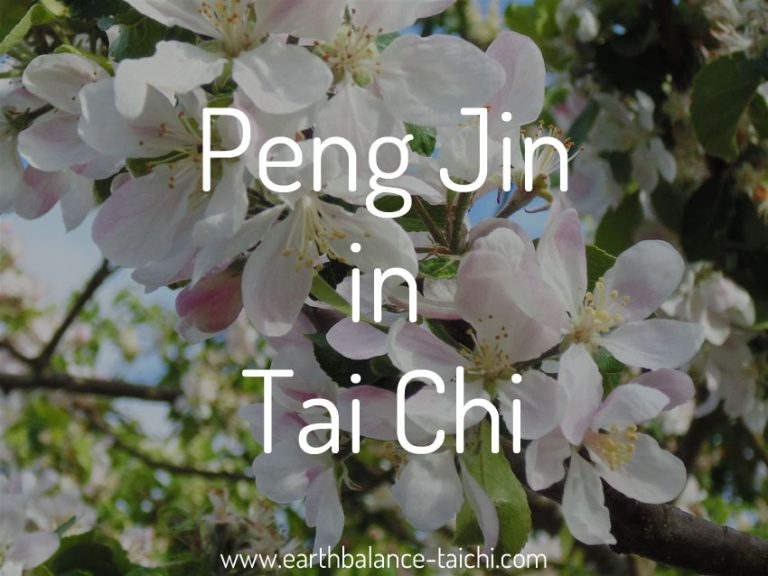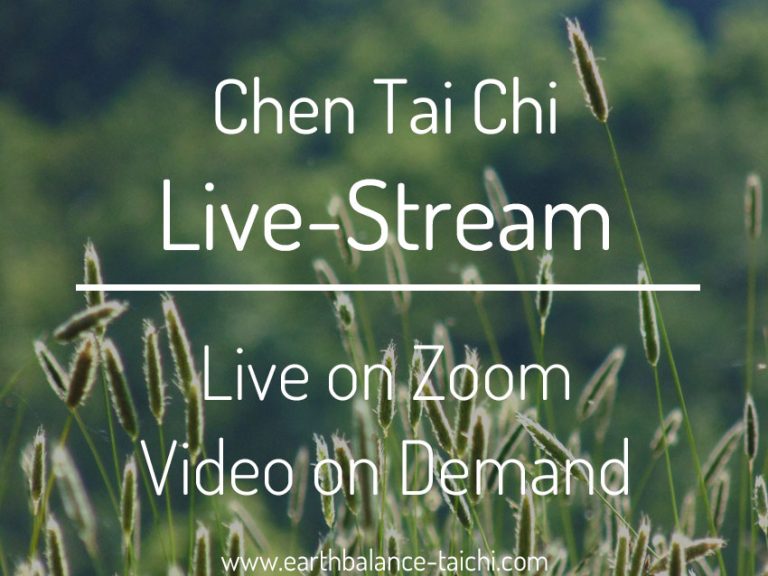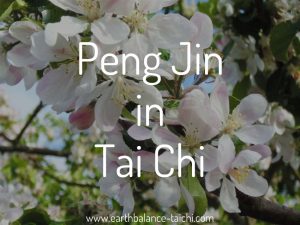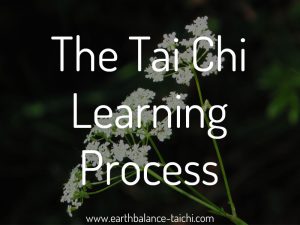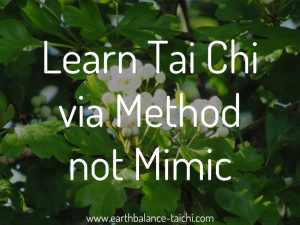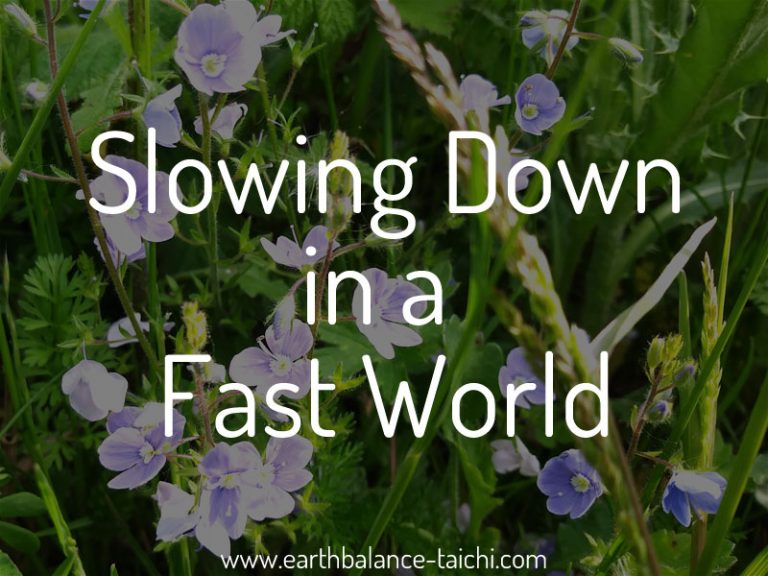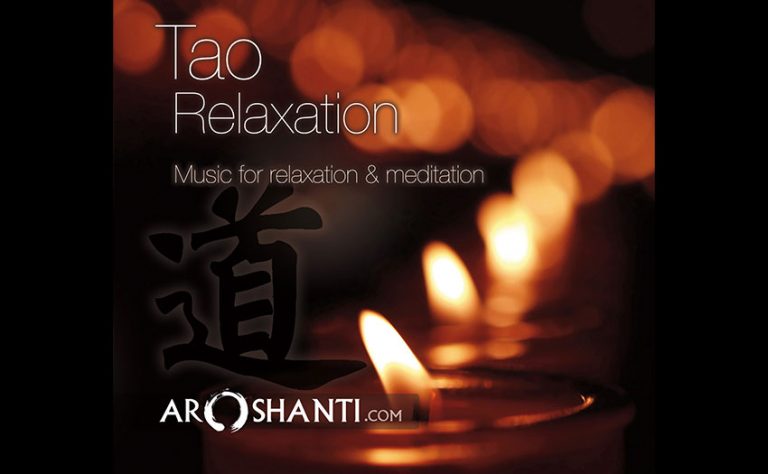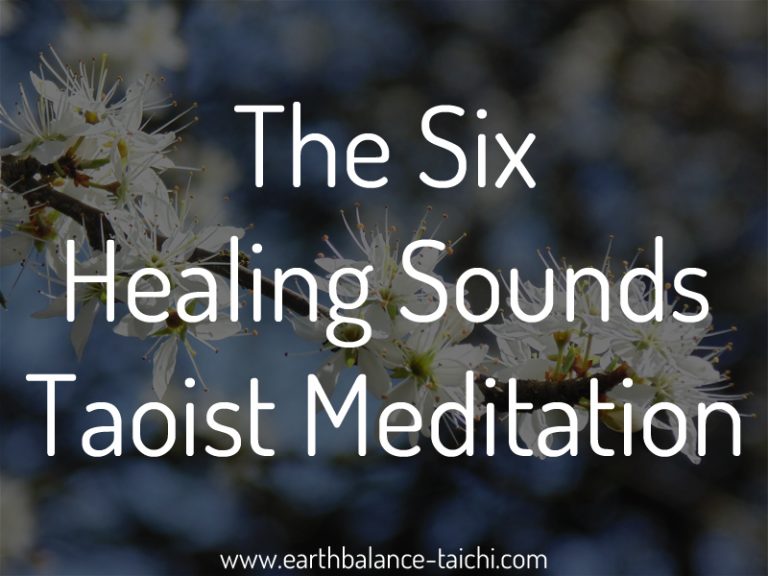Fang Song in Tai Chi
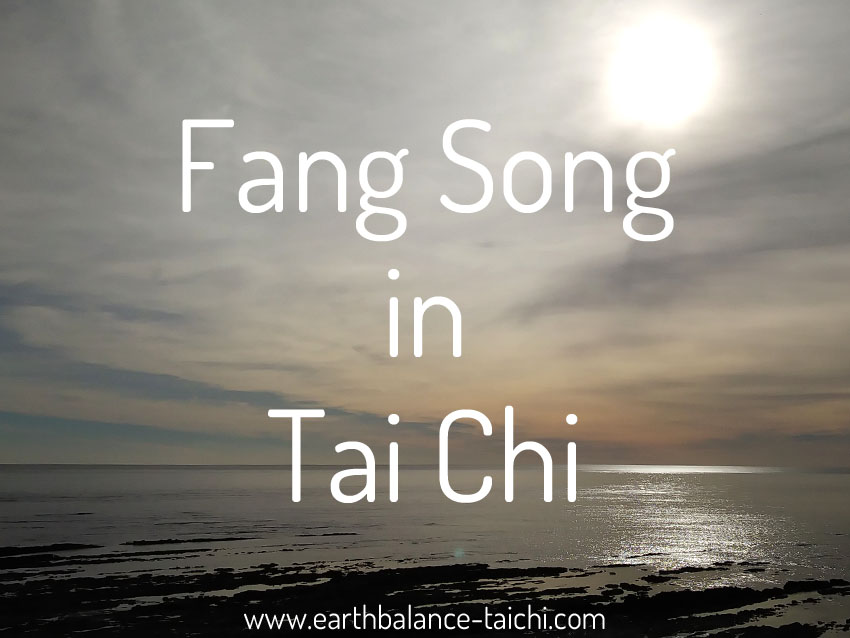
Fang Song in Tai Chi
One of the most important Tai Chi principles is fang song = applied relaxation. To use the least amount of muscular contraction to perform a movement. Which means to release inappropriate muscle contraction, to loosen the joints and to reduce physical tension. I describe it to my students as the absence of resistance. Over the years my teachers have passed on their knowledge and understanding of fang song. This article gives insight into how I have digested this and apply it to my form.
It is also known as fangsong, song or sung. It is a whole body skill that takes time, effort and patience to develop within your structure. It should always be present, although it is easily lost and hard to maintain. The caveat is that relaxation does not mean collapsed or floppy. Instead the body is seen as iron wrapped in cotton.
“A person who is skilled with taijiquan gongfu has arms like cotton wrapped around iron, with extreme heaviness (zhong) and sinking (chen)” - Yang Chengfu’s Taijiquan Theory
- Iron = skeleton, a well aligned and rooted posture covering the 6 directions.
- Iron = martial power, the ability to absorb and create force via body mechanics.
- Cotton = muscles, free of tension, being appropriately contracted to maintain the posture.
- Cotton = joints, free of tension, loosened, mobile and open.
- Connected by = connective tissue, free of tension, elastic, expansive, spiralling and rebounding quality.
Chen Tai Chi Chuan is an internal martial art where brute force and muscular strength are not used. Instead the martial power comes from the internal body mechanics. Without releasing tension the body-mechanics do not work, the person will not able to absorb, create or rebound force. When fang song is present, in performance the person looks fluid and connected, and in martial application the person no matter of their stature can generate or deflect power.
Fang song is also a major principle in Qi Gong training, as moving deliberately and slowly with relaxed joints enables the meridian channels to open, aiding appropriate qi and blood flow. Chronically-contracted muscles and physical tension hinders this, as they cause areas of stagnation and blockages.
Appropriate muscle use / loosened joints = martial power through body mechanics
Martial power through body mechanics = improved health
As health follows the power lines
None of the principles in Tai Chi are effective without fang song. Fang song goes hand in hand with the primary principle peng jin. Peng jin helps to avoid the body from becoming too soft, too relaxed, floppy and collapsed, by adding an expansive quality.
What do you need to develop?
- Skeleton
- Well aligned & rooted posture covering the 6 directions.
- Muscles
- Free of tension, appropriate contraction to maintain posture.
- Joints
- Free of tension, loosened, relaxed, mobile & open.
- Connective tissue
- Free of tension, elastic, expansive, spiralling.
- Mind
- Follows the same principles of song, to be relaxed, calm and present.
Relaxation of physical tension
The majority of people carry chronic muscular tension somewhere in their body. If they have been sedentary in their routine prior to joining a Tai Chi class, they may have little awareness of their body, and may not know how tight they are or how this hinders their posture or movements. It can be difficult as a beginner Tai Chi student to move slowly and smoothly whilst their body is tight, tense and inflexible. Students may be using their muscles disproportionality, with some switched off and some over used. New students may be overloading the muscles by trying to mimic the shape of the instructor's movements, when their muscles don't yet have the integrated strength to hold themselves that way. Typical areas of tension are the shoulders, the hips and the lower back. Students who come to class with previous injuries, tend to hold tension in these areas, to protect and withdraw the injury by hyper-contracting the surrounding muscles. It takes time, patience and focused movement to unpack this type of tension. By practising body awareness to know where muscular tension and hyper-contraction resides, you can take steps to learn how to release and let go. This helps you to equalize muscle use which levels out the load of the weight of your body.
The aim in fang song is to release unnecessary muscular contraction and physical tension. This does not mean all of the muscles are soft, uncontracted and inactive, as this is a popular misconception in the Tai Chi world. This would be impossible to achieve as you need muscle contraction / activation to hold your posture up. When your Tai Chi teacher tells you to 'relax' over and over again, consider the depth of what they mean. Tai Chi is not a muscular strength martial art, it is how you use your muscles that matters. The muscles must function efficiently through whole body connection. Consider the aim of fang song is to have the physique of a cat, fluid, nimble, flexible and agile, rather than pure muscle like a cow, rigid, bulky and inflexible.
Loosening and relaxing the joints
Where there is soft tissue tension, the joints become tight and inflexible. This means the joints may not be able to perform a complete range of motion, which hinders posture and movement, creating sticking points and awkwardness. With a sedentary routine, someone may not realise how tight their joints are, as the do not perform movements that challenge their routine. Over time the range of motion will keep reducing down. If this state occurs over years, it can be very difficult to regain function. The aim of fang song is to deeply relax, loosen and create space and opening in the joints. To foster a ‘neutral’ state where there is no resistance to movement.
Aligning the body
Learning how to correctly align your posture in stillness and movement in your Tai Chi training will aid loosening of the joints and relaxation of the muscles. When the body is aligned well, there isn’t anything out of position. This enables the muscles to work well in unity. An example is, if your head is pushed forwards the muscles of the neck and shoulders are working over time to hold the weight of the head up.
Engaging the connective tissue
Fang song is supported by engaging and lengthening the connective tissue; the fascia, ligaments, tendons and sinews. These have an elastic quality that work along side fang song to suspend the structure whilst softening. Fang song is lost if the connective tissue becomes over taught, to maximum stretch.
Balance
With many elements to consider, it’s a fine balance between tension and collapsed. To maintain an aligned and upright structure, muscles need to contract and the connective tissue needs to engage. Yet too much makes you tight and wooden, and too little collapses your posture. With either extreme you drop all the other principles too. Finding balance is the key.
A beginner’s journey
Part of the journey as a beginner is to train regularly to learn how to release the body from historical and habitual tension, to reduce inappropriate muscular contraction, to equalize muscle use, to loosen and relax the joints and to start re-aligning the posture.
When the muscles are used appropriately in Tai Chi, this can reduce fatigue. Muscles use energy to contract, if your muscles are chronically contracted this is draining your energy. By learning how to hold you body and move your body without tension, this helps restore the body’s energy levels.
When moving in tension, the body will feel and look differently to when moving without tension. The body never lies, tension cannot be hidden in Tai Chi, it comes to the surface easily and drops the other principles. When moving in tension, the weight of the body above the tension will become stuck in a tense joint instead of transferring to the ground. This generally causes more tension, tightness, discomfort and sometimes pain (whether in that moment or later on). The joint the weight gets stuck in may not be a weight bearing joint, which means over time this will damage the joint e.g. lower back and knees.
When that tension is released through an adjustment to your posture and the application of fang song, the weight of the body transfers through the soft tissue to the ground. This means the physical load on the muscles is greater, as it is no longer stuck in a joint. This creates a heavier feeling in the lower body, most noticeably in the leg muscles, with a lighter feeling in the upper body. Over time the lower body muscles grow stronger as they become used to this new way of moving.
With my students I instil the importance of frequent loosening exercises, warm ups, flexibility and mobility drills and Qigong. Movements that take you through a complete range of motion, expanding and compressing the joints, lengthening and stretching the connective tissue, whilst elasticizing the fascia. I also encourage diaphragmatic breathing practice to release physical tension around the diaphragm muscle, connective tissue and organs, and externally around the abdomen, waist, ribs and spine. This also steps into the world of releasing mental tension, which is a by product of fang song practice. My suggestion is a quarter of your training time should be dedicated to loosening. My perspective is that your Tai Chi practice alone is not effective in developing fang song.
Fang song can be trained in traditional standing practice (Zhang Zhuang), which can help students focus their intention without the distraction of movement. I focus on the four major joints of the body in fang song practice, as these areas are the most difficult to release, those being the hips and shoulders. Learning how to release them in stillness and movement is key to progress. It’s a kinaesthetic process involving the right ‘feeling’ brain, where the student has to be able to identify what it feels like internally, so they can replicate that in the future. Students may need physical adjustment to guide them into the right position to aid loosening.
In all of the training I have done, the most important message from my teachers is to relax, and relax more. Understanding what relaxation means is the key to progress. The aim is a neutral body = the absence of resistance.
Chen Tai Chi - Live Online Tuition
Instructor Nicola is passionate about sharing Chen Tai Chi with her students. She provides live online private tuition via Zoom video call from UK time-zone or through distance learning videos at a time convenient to you. The Chen style Tai Chi syllabus covers Chen foundations, silk reeling drills, 5 elements form, 4 corners form, 18 form, 74 form laojia yi lu. Learn through traditional methods to improve the quality of your movements, expand your knowledge and develop your training. Join Nicola's virtual classroom, teaching "from my home to yours".
Chen Tai Chi - Livestream Group Class
Our online group class covers a variety of Chen Tai Chi movements in the Sunday foundations class (jibengong). Each lesson will look focus on the different layers of learning Chen style Tai Chi whilst exploring principles and alignment in movement. The lessons cover a variety of loosening exercises, Qigong breath work, standing practice postures, silk reeling exercises. Find out more.
